Arunachala
Arunachala! Thou dost root out the ego of those who meditate on Thee in the heart, Oh Arunachala!
Arunachala! Thou dost root out the ego of those who dwell on their (spiritual) identity with Thee, Oh Arunachala!
Arunachala is one of the five main Shaivite holy places in South India. The Annamalaiyar Temple, a temple of Lord Shiva is located at the base of the hill. It is also an important place for devotees of Sri Ramana Maharshi, with Sri Ramana Ashram situated at its foothills.
“By seeing Chidambaram, by being born, in Tiruvarur, by dying in Kasi, or by merely thinking of Arunachala, one will surely attain Liberation.”
The hill is referred to in the Puranas as the oldest hill on earth, and is regarded as the heart of the earth owing to its great sanctity. The mountain in this sthala is full of unequaled greatness. The town of Thiruvannamalai (derived from the word malai = mountain), lies at the eastern foot of Arunachala. Within this town there is the 24 acre Arunachaleswarar Kovil, one of the largest Temples in India and around 2,000 years old. The temple grew from a small sanctum-sanctum housing a lingam to its present size, over the course of many centuries.
“All stones in that place Arunachala are lingams. It is indeed the abode of Lord Siva. All trees are the wish-granting trees of Indra‘s heaven. Its rippling waters are the Ganges, flowing through our Lord’s matted locks. The food eaten there is the ambrosia of the Gods. To go round it in Pradakshina is to perform pradakshina of the world. Words spoken there are holy scripture, and to fall asleep there is to be absorbed in Samadhi, beyond the mind’s delusion. Could there be any other place which is its equal?“
-Source: Tamil Arunachala Puranam
The great power of Arunachala’s attraction has been affirmed by countless sages, saints and other persons who have come to the foot of the Mountain. The Hill evokes a tremendous power of radiance and by the power of its ‘energy field’ emits a luminous aura, which is observable during moonless nights. At this place, the conscious substance of the Universe takes on the traits of union between Siva and Sakti with the hill as centre in which all forces counterbalance.
Shaktas regard this hill as Sri Chakra, a diagram of 43 triangle. Some consider that the form of the hill resembles the first half of the Sri Chakra which is called Meruprastana, the emblem of the Cosmos. In one of his Ashtakams, Adi Shankaracharya (who is believed to have visited Arunachala) calls the hill ‘Meru’ and says that siddha purushas are found here and also upon the Himalayas. A vivid description of the glory of Arunachala and the bliss enjoyed by the earnest devotees who worshipped here, is given in many of the Puranas, such as the Sivamaha Purana, Brahmanda Purana, Arunachala Mahatmyam and others.
Video on Arunachala
David Godman on Arunachala
Mythology about Arunachala
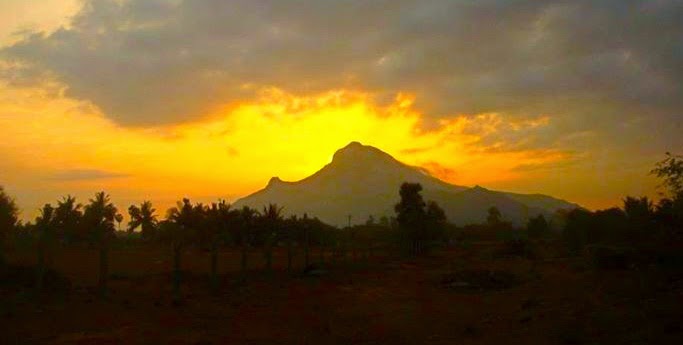
The most famous legend regarding the origin and sanctity of Arunachala and its manifestation as a Lingam at its eastern foot, over which has come into being the Arunachaleshwaraya temple, goes thus:
Lord Brahma, the creator, and Lord Vishnu, the preserver each claimed superiority over the other. Somewhat embarrassed that distinguished Gods of the celestial realm should be engaged in such an altercation, Lord Siva, the Lord of the Universe, appeared before them as a pillar of fire, known as sthanu or lingodbhavamurti. In an effort to arbitrate their discord, Lord Siva declared that, “Whosoever should find either the beginning or the end of this light of mine shall be considered, now and forever more, the superior of you two.”
Upon hearing this, Vishnu took the form of a boar and dug into the depths of the Earth, seeking the beginning of the light. But he was to return disappointed. Brahma became a swan and flew up, seeking the light’s top. He too was about to give up in despair when, by chance, he happened upon a falling flower and embarked upon a conversation with it.
The flower which by name was a screw pine (pandanus odoratissimus), started conversing with Brahma. Eventually the god convinced the flower to support him in a lie to Siva, and that each be the other’s witness to the fact that they had found the end of the pillar of light.
Upon hearing this lie Siva proclaimed that from henceforth Lord Brahma, would not be deified in temples, and the screw pine would not be used in worship. This has indeed come to pass as there are only two Brahma temples (one in Pushkar near Ajmer and the other in Idar State in Rajaputana) and the screw pine is only allowed in the worship of Siva one time a year during Mahashivaratri. Upon the request of the gods Vishnu and Brahma, Siva established himself as the Arunachala Hill and also as a small Lingam at the eastern foot of the hill so that all could worship both as emblems of Siva.
Reference: http://www.arunachalasamudra.org/mythology.html
Giri Pradakshina (Girivalam)
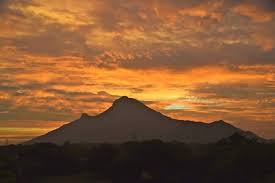 The circumambulation of Arunachala is known as Giri Pradakshina in Sanskrit and Giri Valam in Tamil. Performing pradakshina of Arunachala is considered to be beneficial in all ways. Typically, pradakshina is done in bare feet, with the Hill on the right. Pradakshina (the Hindu rite of going round the object of worship) is “All is within me.” The true significance of the act of going round Arunachala is said to be as effective as circuit round the world. That means that the whole world is condensed into this Hill. The circuit round the temple of Arunachala is equally good; and self-circuit (i.e. turning round and round) is as good as the last. So all are contained in the Self. Says the Ribhu Gita:
The circumambulation of Arunachala is known as Giri Pradakshina in Sanskrit and Giri Valam in Tamil. Performing pradakshina of Arunachala is considered to be beneficial in all ways. Typically, pradakshina is done in bare feet, with the Hill on the right. Pradakshina (the Hindu rite of going round the object of worship) is “All is within me.” The true significance of the act of going round Arunachala is said to be as effective as circuit round the world. That means that the whole world is condensed into this Hill. The circuit round the temple of Arunachala is equally good; and self-circuit (i.e. turning round and round) is as good as the last. So all are contained in the Self. Says the Ribhu Gita:
“I remain fixed, whereas innumerable universes becoming concepts within my mind, rotate within me. This meditation is the highest circuit (pradakshina).’ [Ramana Maharshi, Talks with Sri Ramana Maharshi]
In the Tamil language, this process of going around, is called ‘giri valam’ (giri = mountain and valam = right side), inferring that one should keep the Hill to the right when circumambulating
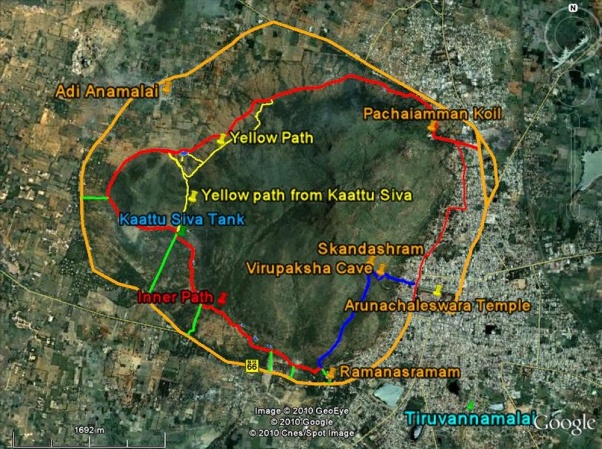
On Giri Pradakshina
Sri Ramana Maharshi once explained the meaning of the word pradakshina and how it should be done by a devotee: “The letter “Pra” stands for removal of all kinds of sins; “da” stands for fulfilling the desires; “kshi” stands for freedom from future births; “na” stands for giving deliverance through jnana.
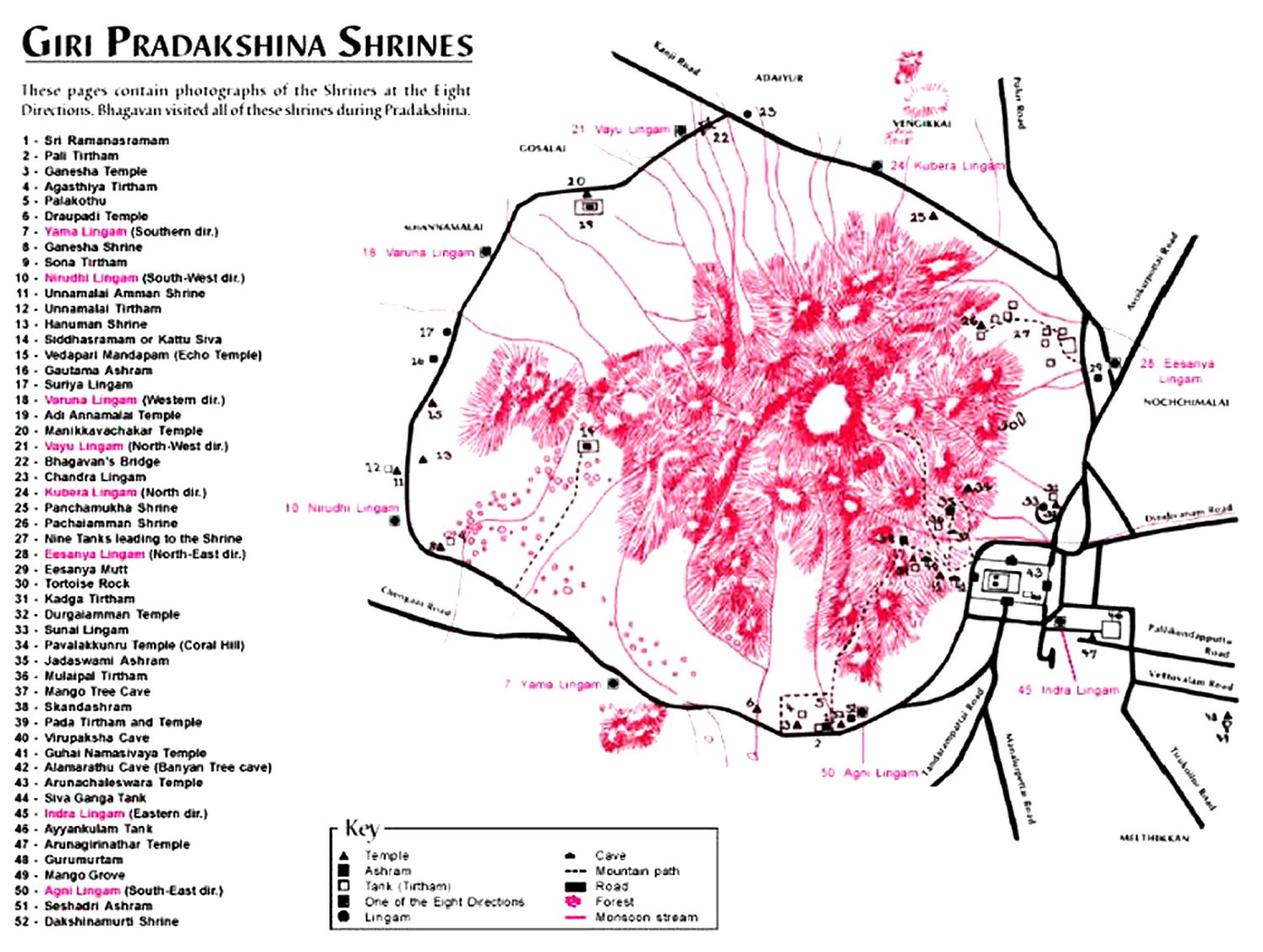
One should go round either in mouna (silence) or dhyana (meditation) or japa (repetition of Lord’s name) or sankeertana (bhajan) and thereby think of God all the time. One should walk slowly like a woman who is in the ninth month of pregnancy.
There are 8 small shrines of lingams located in the 14 km circumference of the hill, each one associated with the 12 moon signs. These are collectively termed as Ashta Lingam(meaning 8 lingams)
The Arunachala Puranam declares that: ‘the holy Arunachala is the primal, Adi linga. The path around its base is the sacred Yoni. Pradakshina of the Hill is therefore pradakshina of the source of all lingas! So one goes round keeping to the left-edge of the path. A mere step taken, confers the benefit of a Yaga, sacrifice; two steps, the fruit of Rajas Yaga; and three that of Asvamedha Yaga. Going round the hill one gains in health and vigour. The hill abounds in rare herbs sought by traditional herbs and the breeze carries the salubrious wafts from these siddha herbs to the one doing the holy round. The dust from the feet of such a person, carried and deposited in towns far away effects immeasurable purification.’
The circumambulation path is 14 kilometres (8½ miles). Tradition has it that even today a number of siddhas are living on the hill. There are eight lingams located at the eight directions, which provides an octagonal structure to the town of Tiruvannamalai. Certain days are regarded as particularly auspicious for circumambulation The fruit of a Sunday pradakshina is Siva’s abode (enter the solar region and attain Liberation); that of Monday is merger in Siva-form (live happily in a world free from senility and death); that of Tuesday is termination of debt and cyclic death (freed from all doubts and becomes Emperor); that of Wednesday is divinity through skill in philosophy and art (attain Wisdom and Omniscience); that of Thursday is lordship over gods and god-men (venerated by all Devas and may even become a renowned Guru); that of Friday is lordship of the Lotus Lady (may hope to reach Vishnu’s abode). A Saturday pradakshina confers the astronomical benefits of a nine-planet conjunction in the Eleventh House (worldly success and protection against planetary influences)
Karthigai Deepam
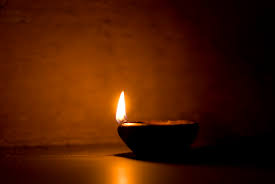 Once a year, the top of Arunachala is alighted with a fire that can be seen for miles around. It is the god Shiva, who is manifesting himself as a blazing pillar of light,In the Deepam Festival is also reflected the union of Shiva and Parvati in the deity Ardhanarishwara.
Once a year, the top of Arunachala is alighted with a fire that can be seen for miles around. It is the god Shiva, who is manifesting himself as a blazing pillar of light,In the Deepam Festival is also reflected the union of Shiva and Parvati in the deity Ardhanarishwara.
Once the goddess in play covered the eyes of her Lord Shiva with her hands, and thus the whole world was plunged into darkness. However, Shiva opened his third eye on the request of the gods, and the light was restored. Uma was ashamed of her childish behavior, and she retired from Mount Kailash to Kanchipuram to do penance and purge herself of her sin. Shiva then directed her to go to Thiruvannamalai to worship him there. Mother Uma became an anchorite and did hard penance, going around Arunachala hill with deep concentration on the holy name of the Lord.
Shiva was pleased with her, and he told her that she was now relieved of her sin which was causing the untimely pralaya (complete destruction of the world). He blessed her and said to her, ‘Come and unite with me,’ and disappeared in the hill. Then on Karthigai the Lord appeared as a blazing light, a jyoti on the top of the hill, and asked Mother Uma to circumambulate the hill. So she did, and when she rounded the western side of the hill, Shiva appeared on his white bull and blessed her. When she rounded the hill on the north-western side he absorbed her into the left half of his body. Thus came into being the form of Ardhanarishwara, the deity that is represented as half male and half female.
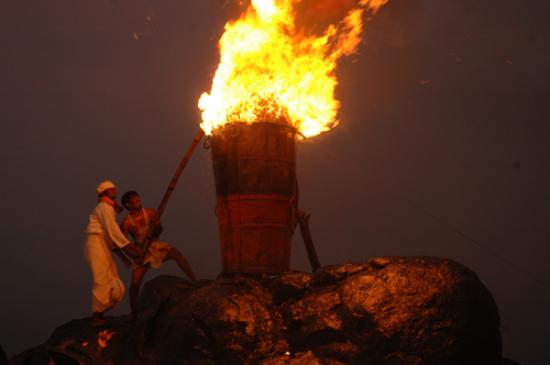
The Deepam Festival lasts ten days, and on each evening a special celebration takes place, that is somehow connected with the history of the holy place. The pilgrims are ordained to fast completely on Kartikeya day and to walk around the hill the entire distance of eight miles. By imitating Mother Uma in this way, the pilgrims draw on the energy that she manifested by her penance, and they also receive the blessings of Lord Shiva.
One of the days before the Deepam is the Car Festival, where the pancha murtis, the five deities of the temple – Annamalainatha (Shiva), Unnamalai Ambal (Uma or Parvati), Vinayagar (Ganesh), Muruga (Kartikeya) and Chandeshwara (Durga), are taken around the perimeter of the 26 acre Arunachaleswarar Temple in huge, towering temple chariots fifteen to twenty meters high drawn by thousands of people with big heavy iron chains.
On another evening, Shiva and Parvati form a procession in the streets on their huge silver bull Nandi, or the utsavas, the processional bronze images of the deities, are taken out in a magnificent silver car. Or the deities enjoy a merry boat ride in beautifully decorated boats on the temple tank. All processions are headed by musicians playing flutes and big temple drums, and the light of many torches gleam from the jewelled dresses of the utsavas and lights the faces of the devotees, who receive their gods with folded hands, bowing down to the ground. Wherever the deities are carried through the streets, mostly at night, people stand in front of the houses with plates prepared with prasad, which is then blessed by the gods and the coconut broken, when the pundits are doing aarti (worship) in front of the deities.
Before a procession, abhiskeham (ritual anointment) and aarti are performed on the pancha murti utsavas. Silver and gold ornaments are brought out from the temple treasury and the utsavas are dressed and the main puja begins.
For hours the gods are showered with scented rose petals, sprinkled with rose water and garlanded under continuous recitation of mantras in the mist of the smoke from oil lamps and burning ghee. In this way the deities are well prepared for the manifestation of divine light on the evening of Karthigai. In the early hours of the morning on Karthigai day, the solemn ritual of preparing the five holy fires in five agantams (round vessels) is performed in the sanctum sanctum of Annamalaiyar and they are kept burning until the evening.
At the mystic hour of dusk (pradosha), when crowds of people have gathered in the courtyards and on the roofs of the temple, waiting since early morning, the pancha murtis, are carried out into the courtyard in a fast running motion, sitting in their golden palanquins covered with festoons, on the waves of sounds from the wonder-struck crowds. The deities are placed in a mandapam (ceremonial pavilion) opposite the entrance to the Arunachaleshwara temple, facing the holy mountain.
At the moment when the sun is setting behind the western horizon and the full moon is rising in the east, the five deepams are brought out from the temple and placed in a big cauldron near the flagstaff. At that same moment the beacon light is lit on the top of Arunachala, and with one voice the crowd roars ‘Harohara to Annamalai’. At that time also the deity Ardhanarishwara is brought out and placed on the stairs of the temple close to the big deepam. The excited pilgrims crowd and push to touch the holy fire, and puja is done before the pancha murtis in the mandapamuntil the early hours in the morning.
Many tons of ghee have been carried up the steep, stony hill on bare feet, and the divine light will be shining from the top of Arunachala for nearly one week. All through the night, pilgrims climb the mountain to bring down the holy fire in small earthenware deepams, so from below a constant row of flickering lights can be seen zigzagging down the hillside like a line of small glow worms. Throughout the next day a stream of pilgrims murmuring the mantra ‘Harohara’ climb the steep and stony path on bare feet to worship the divine fire, burning in a huge copper urn, and fill their deepams or containers with holy ghee to burn in their small temples or pujarooms at home, a symbol of lighting the inner fire or jyoti, dispelling the darkness of the soul.
Thus in the life of the pilgrim, the Deepam Festival is an experience of transcending time and space and of being elevated to participate in the powers of the divine world. One leaves this holy place after ten eventful days purified, renewed and in an altered state of being. By the grace of God, the pilgrim might even have undergone a slight transformation through being exposed to the manifestation of so much spiritual energy, rising one step higher on the path towards enlightenment.
Arunachaleshwara temple
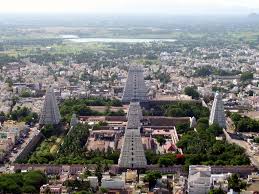
Sri Arunachaleswarar Temple at Thiruvannamalai is one of the most ancient Temples of Lord Siva in Tamil Nadu. Many ancient rulers of South India have contributed to the development of this Temple. The Pallavas, the Cholas, the Pandiyas, the Kadavarayas, the Banas, the Hoysalas, the Rayas of Vijayanagar, and the Nayaks of Thanjavur have altered, extended and developed the vast Temple complex for nearly a thousand years. The 500 inscriptions of Thiruvannamalai clearly bring out the history of the construction and development of the mighty structure of the Temple.
The nine temple towers/gopurams
The innermost shrine of Sri Arunachaleswarar Temple opens to the east and accommodates the principal deity of Lord Shiva. The courtyards or prakarams are counted, starting from the centre. The Temple has nine towers, four in the outer walls, each in every direction. It has nine vimanas with beautiful architecture. There are three miniature towers of 70 feet height which are called “Kettai Gopurams” connecting the inner walls. Three towers are in the eastern side of the Temple with two towers in each direction of South, West and North. Rajagopuram, Vallala Maharaj Gopuram, and Kiligopuram are in the eastern side of the Temple. The southern tower is called Thirumanjana Gopuram. The western tower is named Peygopuram, which was originally Peyalvar Gopuram. The northern tower is called Ammani Amman Gopuram. These magnificent impressive towers are among the finest in Tamil Nadu and can be compared with those of Chidambaram, Srirangam, Jambukeswaram, Madurai and Rameshwaram.
Sivagangai theertham
To the south of the Kambathu Illaiyanar Temple there is the sacred tank called
Sivagangai Theertham. Sivangagai is the name of a river in Kailayam, the abode of Lord Siva. The Theertham is named after the river. There is also a Theertham called Sivagangai in Chidambaram. It has stone steps and Thirumalapathi Mandapam on all four sides. This Theertham is used for sacred ablutions of the Temple deities. The Theertham (with steps all round) presents a panoramic view. Inscriptions reveal that water to this (Theertham) was provided by digging a canal called Thirumalai Amman Devi Samduram. There is a verse which proclaims that Sevappa Naickan the ruler of Tanjore, built a tower and dug a tank in 1572 A.D.
The Thousand Pillared Mandapam
The Thousand Pillared Hall in the fifth prakaram was built by Krishnadevaraya. This Thousand Pillared Hall has exactly 1000 pillars. The pillars are carved with sculptures of the Nayak period and some divine images of sages. Vishnu’s incarnations too find a place with floral designs. It was engraved with figures and the roof with numerous stone Nandis. The basement of this Mandapam is adorned with the designs of girls playing kolattam, warriors, sports. etc. This Mandapam is used for the Deities to be seated and for ablutions and worship on Ani Thirumanjanam and the day of Thiruvathirai.
A copper plate of sagam 1435 reveals that the land site of 275 feet east west and 295 feet north south was sold to Krishnadevaraya for 500 sovereigns of gold by the members of a great mutt in Tiruvannamalai. There is the Patala Shrine in the underground chamber of the thousand pillared Mandapam.
The Katchi Mandapam
On entering into the Third Prakaram one can see the spectacular Temple of Annamalaiyar and the Aruna Linga Mountain. After crossing the entrance of the Kili Gopuram. One will first step into a vast sixteen pillared Mandapam. This Mandapam is called Katchi Mandapam because the Panchamurthis give darshan on the day of Karthigai Deepam. Arthanareeswara too gives darshan from this place. Devotees watch the Holy Beacon from this Mandapam on Deepam day. Hence this is also called Deepa Tharisana Mandapam. This Mandapam was built by Mankaiyakarsi a devote in 1202 A.D. Hence it was originally named as the Manakaiyakarasi Mandapam. From this place one can see the flagpole and a small Nandi in front of Arunachaleswarar Temple.
Sri Sambanda Vinayagar Shrine
Sambathar Vinayagar Shrine is located in the area to the south of the Flag staff and Balipeedam. Sambanda Vinayagar looks crimson smeared with saffron. Hence it is called Sennira Vinayagar (Red Vinayagar). The idol which is very large is considered to be one of the biggest images of Ganapathi in Tamil Nadu. This huge Vinayagar is in sitting pose.
The Temple of Unnamulaiyamman
The Temple of Unnamalaiyamman has been erected in the northwest corner of the third Prakaram. This is a separate structure in the sacred complex of Sri Arunachaleswarar Temple. The Amman Temple is situated on the south. The wall of the Amman Temple is about 10 feet high. The emblem of Hoysala, (the Kandaperanda Bird) is found and nearby there is also a statue of a standing man with worshipping hands. The standing man is identified as Ballala. Hence it is presumed that the outer walls might have been built by the Hoysala King. The Navagraha Shrine, the Kodemara Mandapam, the Astalakshmi Mandapam and the Sanctum Sanctorum are important structures of the Unnamalaiyamman Temple.
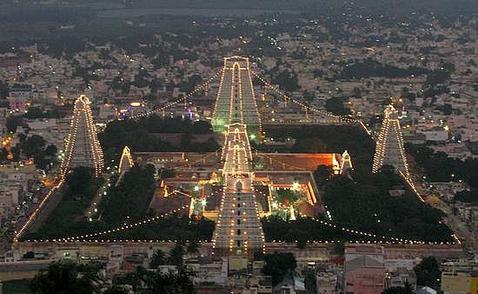 Aksharmanmallai
Aksharmanmallai
This joyful Marital Garland of Letters, which resembles a beam of the rays of the rising sun, was sung by the noble sage, Ramana, the ocean of compassion, with the object of removing the delusion of the devotees who sought his grace. Those who look upon it as their sole refuge will realize within themselves that they are Arunāchala and will reign in the world of Siva. This composition is sung by Bhagavan’s devotees all over the world.
Click here to download Aksharmanmallai in pdf format.
Aksharmanamallai with English translations of all verses
Important links on Arunachala
- Learning to sing Aksharmanmallai from Ramanashram
- Arunachala birds blog
- Arunachala animal rescue organization
- Arunachala mystics blog
- Jigsaw puzzles on Arunachala
- Arunachaleshwar Temple
- Pradakshina relevance
- Various blogs on arunachala like birds, mystics etc
- Aksharmanmallai tamil parayana with meaning
- Aksharmanamallai
- Tamil parayana with ramanashramam images and significance of arunachala pradakshina
- Live Web Camera Images of Arunachala
